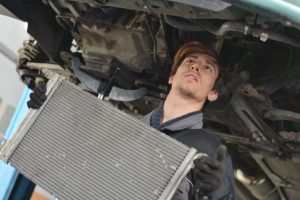Your engine generates a large amount of heat as it operates. The heat must be removed to prevent damage to the engine. Your Hyundai radiator is responsible for removing engine heat and replacing it with cooler outside air. In time a radiator can become worn or damaged, and you’ll need a radiator repair at your Hyundai dealer. These are some signs that your radiator could be in trouble.
Signs You Need a Radiator Repair at Your Hyundai Dealer
Temperature Gauge Rising

The temperature gauge on your dash panel monitors your engine’s internal temperature. Under normal conditions, your engine operates between 180 F and 225 F. If you’re driving uphill or towing a heavy load, the temperature may spike temporarily. The cooling system will then increase speed, and the engine temperature will drop again.
A steadily rising temperature is a sign that something is wrong with the cooling system. The radiator could be clogged, a hose could be blocked, or coolant may not be flowing through your engine. If you drive with a failing cooling system, you risk an overheated engine. Our technicians will need to examine your engine to find the cause of the problem and then fix it.
Damaged Radiator Cap
The cooling system operates at high speed and under high pressure. This is essential as it allows the cooling system to respond to any temperature increases efficiently. If your engine temperature goes up, the cooling system will speed up in response. The radiator cap is mounted at the top of your radiator and controls the cooling system pressure.
The cap is securely attached and has two seals that protect against pressure loss. The constant high pressure and heat can eventually damage these seals, and coolant could leak out. If this happens, the cooling system’s pressure and speed will drop. Your engine temperature will steadily rise due to reduced cooling. We’ll examine the cap and its seals and replace them if they’re damaged.
Coolant Leaks
Liquid coolant is vital for the cooling system, as it absorbs heat generated by the hot engine components. It then transports the heat to the radiator, where the heat is removed by heat exchange inside the radiator fins. Constant high temperature and pressure can lead to damage in the cooling system and coolant can leak out.
Leaking coolant is usually easy to identify, as it is pink, green, blue, or yellow. If coolant leaks into your engine, you’ll see evidence of this as your exhaust smoke will change to a cloud of thick white smoke. The color change is due to the water in the coolant. A coolant leak needs to be repaired promptly to prevent engine damage. We’ll trace the source of the leak and permanently seal it.
If your car is running hotter than it should, call us immediately at Coughlin Hyundai of Heath.





